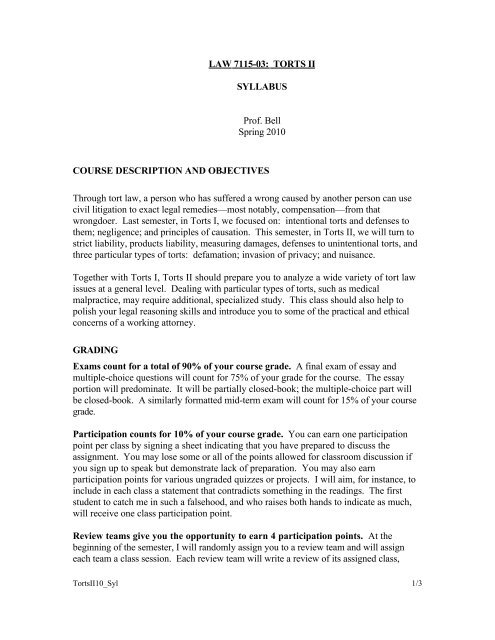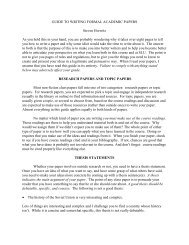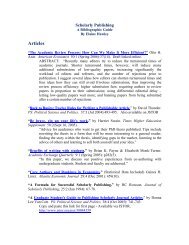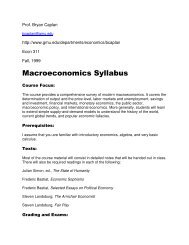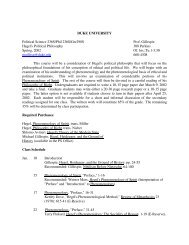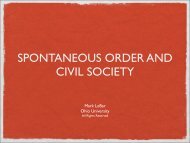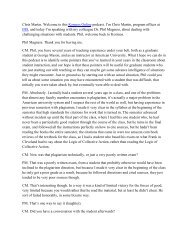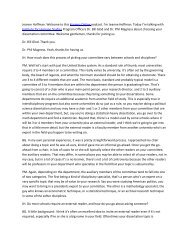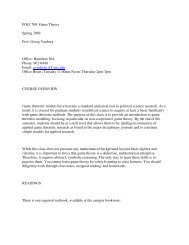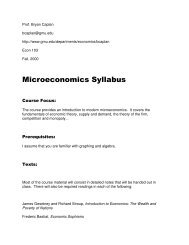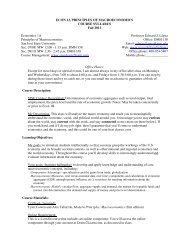LAW 7115-03: TORTS II SYLLABUS Prof. Bell Spring ... - Tom W. Bell
LAW 7115-03: TORTS II SYLLABUS Prof. Bell Spring ... - Tom W. Bell
LAW 7115-03: TORTS II SYLLABUS Prof. Bell Spring ... - Tom W. Bell
Create successful ePaper yourself
Turn your PDF publications into a flip-book with our unique Google optimized e-Paper software.
<strong>LAW</strong> <strong>7115</strong>-<strong>03</strong>: <strong>TORTS</strong> <strong>II</strong><br />
<strong>SYLLABUS</strong><br />
<strong>Prof</strong>. <strong>Bell</strong><br />
<strong>Spring</strong> 2010<br />
COURSE DESCRIPTION AND OBJECTIVES<br />
Through tort law, a person who has suffered a wrong caused by another person can use<br />
civil litigation to exact legal remedies—most notably, compensation—from that<br />
wrongdoer. Last semester, in Torts I, we focused on: intentional torts and defenses to<br />
them; negligence; and principles of causation. This semester, in Torts <strong>II</strong>, we will turn to<br />
strict liability, products liability, measuring damages, defenses to unintentional torts, and<br />
three particular types of torts: defamation; invasion of privacy; and nuisance.<br />
Together with Torts I, Torts <strong>II</strong> should prepare you to analyze a wide variety of tort law<br />
issues at a general level. Dealing with particular types of torts, such as medical<br />
malpractice, may require additional, specialized study. This class should also help to<br />
polish your legal reasoning skills and introduce you to some of the practical and ethical<br />
concerns of a working attorney.<br />
GRADING<br />
Exams count for a total of 90% of your course grade. A final exam of essay and<br />
multiple-choice questions will count for 75% of your grade for the course. The essay<br />
portion will predominate. It will be partially closed-book; the multiple-choice part will<br />
be closed-book. A similarly formatted mid-term exam will count for 15% of your course<br />
grade.<br />
Participation counts for 10% of your course grade. You can earn one participation<br />
point per class by signing a sheet indicating that you have prepared to discuss the<br />
assignment. You may lose some or all of the points allowed for classroom discussion if<br />
you sign up to speak but demonstrate lack of preparation. You may also earn<br />
participation points for various ungraded quizzes or projects. I will aim, for instance, to<br />
include in each class a statement that contradicts something in the readings. The first<br />
student to catch me in such a falsehood, and who raises both hands to indicate as much,<br />
will receive one class participation point.<br />
Review teams give you the opportunity to earn 4 participation points. At the<br />
beginning of the semester, I will randomly assign you to a review team and will assign<br />
each team a class session. Each review team will write a review of its assigned class,<br />
Torts<strong>II</strong>10_Syl 1/3
which it will present at the start of the following class session. Each qualifying team<br />
member will receive 4 points for that exercise. For details, please see the separate<br />
handout.<br />
HOW TO CONTACT ME<br />
I encourage you to contact me if you have questions or comments about what we discuss<br />
in class or about law school in general. Look for me at my office, room 438, each<br />
Monday and Wednesday, from 9 a.m. until 10:10 a.m., and again from 11:40 a.m. until 1<br />
p.m. I also hold office hours each Wednesday from 2:30 p.m. until 4:00 p.m. I welcome<br />
you to drop by and chat at those times or at other times by appointment or chance. You<br />
can also call me at 714/628-25<strong>03</strong> or email me at . You can find<br />
course materials at .<br />
READING ASSIGNMENTS<br />
This syllabus sets forth the readings assigned from the course's text, <strong>TORTS</strong>: CASES AND<br />
QUESTIONS (Farnsworth & Grady, eds., 2nd ed., 2009). You should read all of these<br />
citations inclusively; "1-5," for instance, means "1, 2, 3, 4, and 5." Please note that while<br />
I will make a good faith effort to follow this syllabus, I reserve the right to change it.<br />
class # assignment (# of pages)<br />
Introduction<br />
Class 1: pp. 395, 462-465, 517, 571, 613, 693-96, 749 (9)<br />
Ch. 7. Strict Liability<br />
Class 2: pp. 396-406 (11)<br />
Class 3: pp. 406-16 (9)<br />
Class 4: pp. 416-429 (note 6), 430-32 (note 9) (14)<br />
Class 5: pp. 433-34, 437-448 (12)<br />
Ch. 8. Products Liability<br />
Class 6: pp. 449-462 (13)<br />
Class 7: pp. 462-470 (n. 1), 473-479 (15)<br />
Class 8: pp. 479-486, 489 (n.4)-494 (13)<br />
Class 9: pp. 494-5<strong>03</strong> (9)<br />
Torts<strong>II</strong>10_Syl 2/3
Ch. 9. Damages<br />
Class 10: pp. 517-529 (n. 2) (14)<br />
Class 11: pp. 538-552 (14)<br />
Class 12: pp. 552-561 (n. 4) (10)<br />
Class 13: pp. 561 (n. 5)-569 (8)<br />
Midterm Exam<br />
Class 14: (administered in-class on Wednesday, March 10)<br />
Ch. 10. Defenses<br />
Class 15: pp. 571-587 (16)<br />
Class 16: pp. 587-596 (10)<br />
Class 17: pp. 596-602 (n. 3), 6<strong>03</strong> (n.5)-607, 609-611 (11)<br />
Ch. 11. Defamation<br />
Class 18: pp. 613-626 (13)<br />
Class 19: pp. 626-627, 631 (n.6)-644 (n. 1) (13)<br />
Class 20: pp. 644 (n. 2)-647 (n. 6), 650-659 (14)<br />
Class 21: pp. 659-676 (17)<br />
Class 22: pp. 676-687 (n.4), 691-92 (11)<br />
Ch. 12. Invasion of Privacy<br />
Class 23: pp. 693-696, 705-716, 722 (n. 10) (16)<br />
Class 24: pp. 723-734 (12)<br />
Class 25: pp. 737-748 (11)<br />
Ch. 13. Nuisance<br />
Class 26: pp. 749-761, 765-769 (17)<br />
Class 27: pp. 773-774, 780 (n. 7)-782 (n. 8), 784-791 (11)<br />
Review<br />
Class 28: (review) (0)<br />
Torts<strong>II</strong>10_Syl 3/3


